We’ve discovered the perfect way to bring authentic Japanese flavors into your kitchen with our foolproof green tea mochi recipe. This beloved treat combines the earthy richness of matcha with the delightfully chewy texture that makes mochi so irresistible. Traditional Japanese confectioners have perfected this sweet for centuries, and now you can master it at home.
Making green tea mochi might seem intimidating, but we’ll guide you through each step with confidence. The vibrant green color and subtle tea flavor create an elegant dessert that’s perfect for special occasions or whenever you’re craving something unique. Unlike store-bought versions, homemade mochi offers that perfect balance of sweetness and authentic matcha taste.
We’ll show you how to achieve that signature soft, stretchy texture using simple ingredients you can find at most grocery stores. Get ready to impress your family and friends with this stunning Japanese delicacy that tastes as beautiful as it looks.
Ingredients
Creating authentic green tea mochi requires carefully selected ingredients that work together to achieve the perfect texture and flavor. We’ve organized these ingredients by component to streamline your preparation process.
For the Mochi Dough
- 1 cup glutinous rice flour (mochiko)
- 1/4 cup granulated sugar
- 1 cup water
- 1 tablespoon vegetable oil
- 1/4 teaspoon salt
- Green food coloring (optional, 2-3 drops)
For the Green Tea Filling
- 1 cup heavy cream
- 1/4 cup powdered sugar
- 2 tablespoons high-quality matcha powder
- 1 tablespoon honey
- 1/4 teaspoon vanilla extract
- Pinch of salt
For Dusting
- 1/2 cup potato starch or cornstarch
- 2 tablespoons powdered sugar
- 1 teaspoon matcha powder (for color and extra flavor)
Equipment Needed
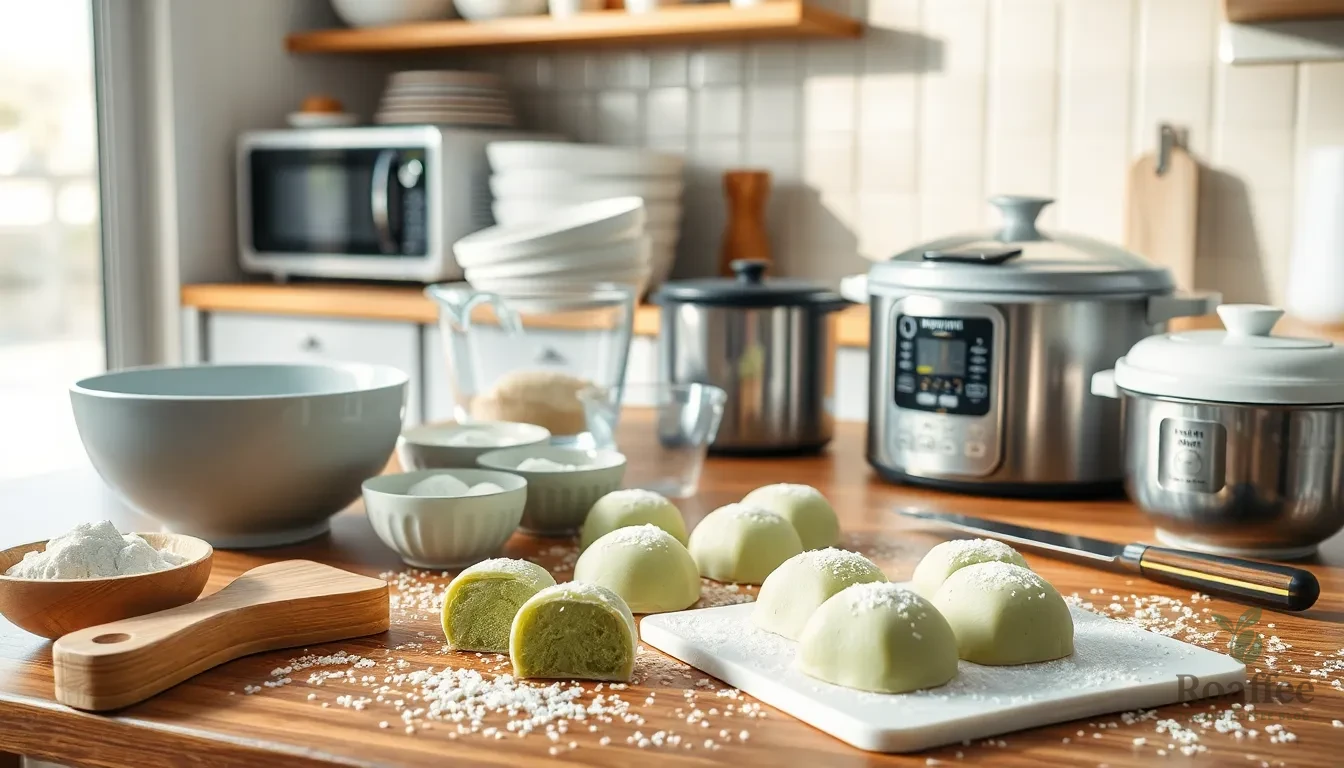
Creating perfect green tea mochi requires exact tools that ensure smooth preparation and professional results. We recommend gathering these essential items before starting your mochi-making journey.
Mixing bowls serve as your primary workspace for combining ingredients and preparing both the dough and filling components. Choose medium to large bowls that provide ample space for whisking without spillage.
Measuring cups and teaspoons guarantee accuracy in your ingredient ratios, which is crucial for achieving the ideal mochi texture. Precise measurements prevent common issues like overly sticky or tough mochi dough.
Microwave-safe bowl or heatproof bowl becomes essential for cooking the mochi dough using either microwave intervals or traditional steaming methods. Glass or ceramic bowls work best as they distribute heat evenly and won’t react with the ingredients.
Steamer offers the traditional cooking method for those who prefer authentic preparation techniques over microwave cooking. While optional, steaming provides more controlled heat distribution for consistent results.
Whisk or spoon helps you mix the batter thoroughly and eliminate lumps that could affect the final texture. A whisk works particularly well for incorporating the matcha powder smoothly into the mixture.
Plastic wrap or greaseproof paper protects your dough from drying out during the cooking process and prevents surface film formation. This covering maintains the proper moisture balance throughout preparation.
Chopping board and knife assist in shaping the mochi and cutting any ganache filling into uniform portions. A clean, smooth cutting surface makes the shaping process much easier.
Oven tray or smooth surface provides an ideal workspace for rolling and shaping the mochi skin. Choose a surface that won’t absorb moisture or stick to the dough.
Cornstarch or potato starch prevents sticking during the shaping process and allows you to handle the mochi dough without it adhering to your hands or work surface. Keep extra starch nearby for dusting throughout the process.
| Equipment Category | Essential Items | Purpose |
|---|---|---|
| Mixing Tools | Bowls, whisk, spoon | Ingredient preparation and mixing |
| Measuring Tools | Cups, teaspoons | Accurate ingredient ratios |
| Cooking Equipment | Microwave-safe bowl, steamer | Dough cooking methods |
| Shaping Tools | Board, knife, tray | Mochi formation and cutting |
| Non-stick Materials | Plastic wrap, starch | Moisture control and easy handling |
Instructions
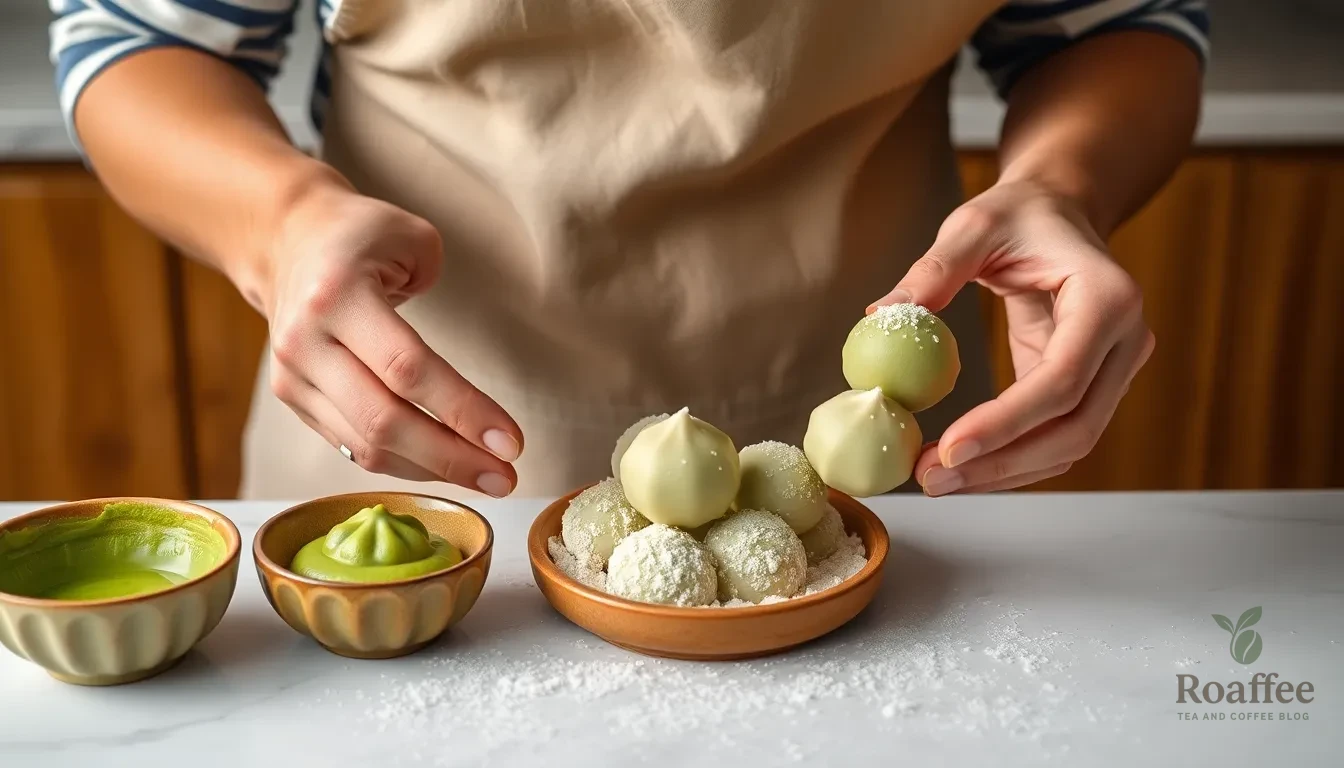
We’ll guide you through each step to create perfect green tea mochi with authentic flavor and texture. Our method ensures consistent results every time.
Prepare the Green Tea Filling
Begin by combining the heavy cream and powdered sugar in a mixing bowl. Whisk until the mixture forms soft peaks. Add the high-quality matcha powder gradually while continuing to whisk to prevent clumps from forming. Incorporate the honey and vanilla extract until the filling achieves a smooth consistency. Add a pinch of salt to enhance the matcha flavor profile.
Transfer the green tea filling to a piping bag or small spoon for easy portioning. Chill the mixture in the refrigerator for 30 minutes to firm up the consistency. This step makes the filling easier to handle during assembly.
Make the Mochi Dough
Combine the glutinous rice flour and granulated sugar in a microwave-safe bowl. Whisk the dry ingredients together thoroughly to eliminate any lumps. Gradually add the water while stirring continuously until the mixture reaches a smooth consistency.
Add the vegetable oil and salt to the mixture. Stir until all ingredients are fully incorporated. Cover the bowl with a damp paper towel to prevent the surface from drying out.
Microwave the mixture in 30-second intervals for a total of 90 seconds to 2 minutes. Stir between each interval to ensure even cooking. The dough is ready when it turns translucent and pulls away from the sides of the bowl easily.
Assemble the Mochi
Dust a clean work surface generously with potato starch or cornstarch. Transfer the hot mochi dough onto the prepared surface using a spatula. Allow the dough to cool for 2-3 minutes until it’s comfortable to handle.
Dust your hands with starch to prevent sticking. Divide the dough into 8 equal portions using a knife or bench scraper. Roll each portion into a ball then flatten into a 4-inch circle.
Place approximately 1 tablespoon of the chilled green tea filling in the center of each circle. Gather the edges of the mochi dough around the filling. Pinch and twist the seam tightly to seal completely.
Final Shaping and Dusting
Roll each filled mochi ball gently between your palms to create a smooth round shape. Dust any sticky spots with additional starch as needed. Place the completed mochi on a parchment-lined tray.
Dust each mochi lightly with a mixture of powdered sugar and matcha powder for an elegant finish. Allow the mochi to rest at room temperature for 10 minutes before serving to let the flavors meld together.
Directions for Serving
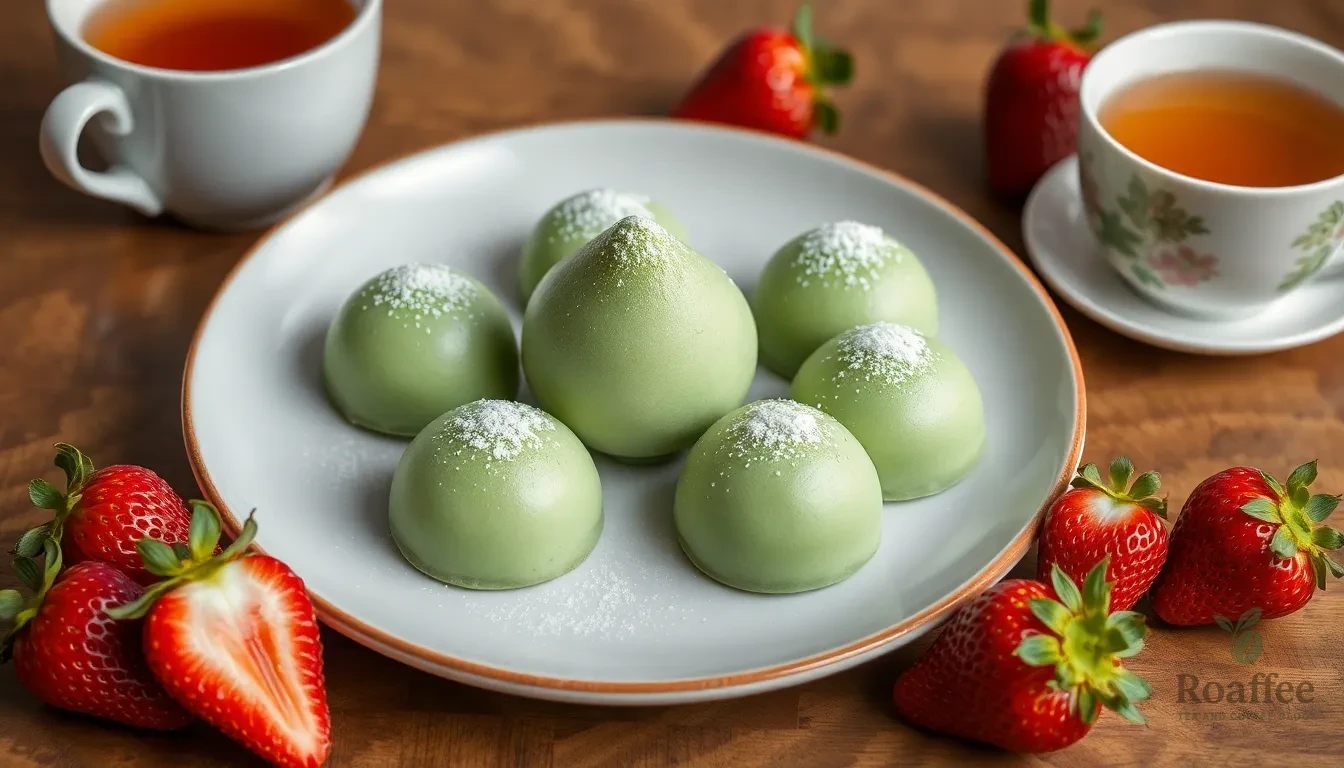
We recommend serving our green tea mochi immediately after preparation for the best texture and flavor experience. Fresh mochi offers the perfect balance of soft exterior and creamy filling that makes this dessert truly exceptional.
Temperature and Timing
We suggest serving the mochi at room temperature for optimal taste. Allow the finished mochi to rest for 15-20 minutes after assembly, which helps the flavors meld beautifully while maintaining the ideal chewy texture.
Presentation Options
We arrange our green tea mochi on a clean serving plate dusted lightly with the matcha-powdered sugar mixture. Individual pieces can be placed in paper cupcake liners for elegant presentation at parties or special occasions.
Portion Guidelines
We typically serve 2-3 pieces per person as a dessert portion. The rich matcha filling and satisfying mochi texture make smaller servings surprisingly satisfying.
Storage for Later Serving
We store leftover mochi in an airtight container at room temperature for up to 24 hours. Beyond this timeframe, the texture begins to firm and lose its signature softness. We avoid refrigerating mochi as cold temperatures cause the rice flour to harden significantly.
Pairing Suggestions
We love serving our green tea mochi alongside hot jasmine tea or light oolong tea. The warm beverage complements the cool, creamy filling while improving the matcha’s earthy notes. Fresh fruit like strawberries or Japanese pears also pair wonderfully with the sweet, grassy flavors.
Special Occasion Serving
We dust our serving area with additional matcha powder for an elegant presentation during tea ceremonies or dinner parties. Small bamboo picks can be provided for easy handling, though we encourage guests to enjoy the mochi in one or two bites to fully appreciate the texture contrast.
Storage Instructions
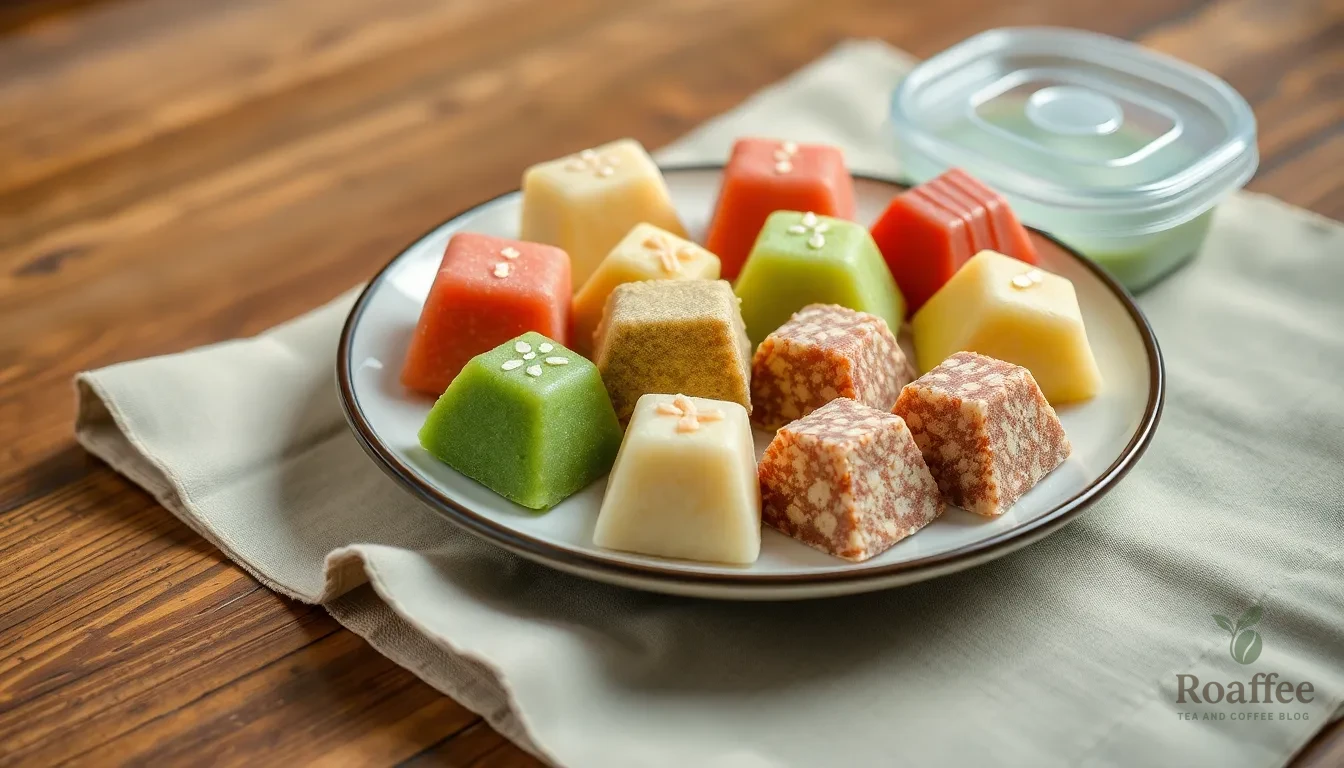
We recommend storing your freshly made green tea mochi properly to maintain its signature soft texture and vibrant matcha flavor. Room temperature storage works best for short-term enjoyment.
Room Temperature Storage
Store your green tea mochi in an airtight container at room temperature for 1 to 2 days maximum. We suggest placing parchment paper between layers to prevent the mochi from sticking together. This method preserves the ideal chewy texture that makes mochi so special.
Refrigeration Guidelines
For longer storage, we can refrigerate the mochi tightly wrapped in plastic wrap or stored in an airtight container. Refrigerated green tea mochi stays fresh for up to one week, though the texture becomes firmer than when stored at room temperature.
| Storage Method | Duration | Texture Notes |
|---|---|---|
| Room Temperature | 1-2 days | Optimal soft texture |
| Refrigerated | Up to 1 week | Firmer texture |
| Frozen | Several months | Requires thawing |
Freezing for Extended Storage
We can freeze green tea mochi for several months when properly stored. Wrap each piece individually in plastic wrap, then place them in an airtight container or freezer bag. This prevents freezer burn and maintains quality during long-term storage.
Pre-Serving Storage Tips
For the best eating experience, we recommend allowing refrigerated mochi to come to room temperature for 15-20 minutes before serving. This brief resting period helps restore some of the original soft texture. Frozen mochi should thaw completely at room temperature before consumption.
Storage Containers and Materials
We use airtight containers with tight-fitting lids to prevent moisture loss and maintain freshness. Glass containers work exceptionally well, though plastic containers with secure seals also provide adequate protection. Always ensure your storage container is clean and completely dry before adding the mochi.
Tips for Perfect Green Tea Mochi
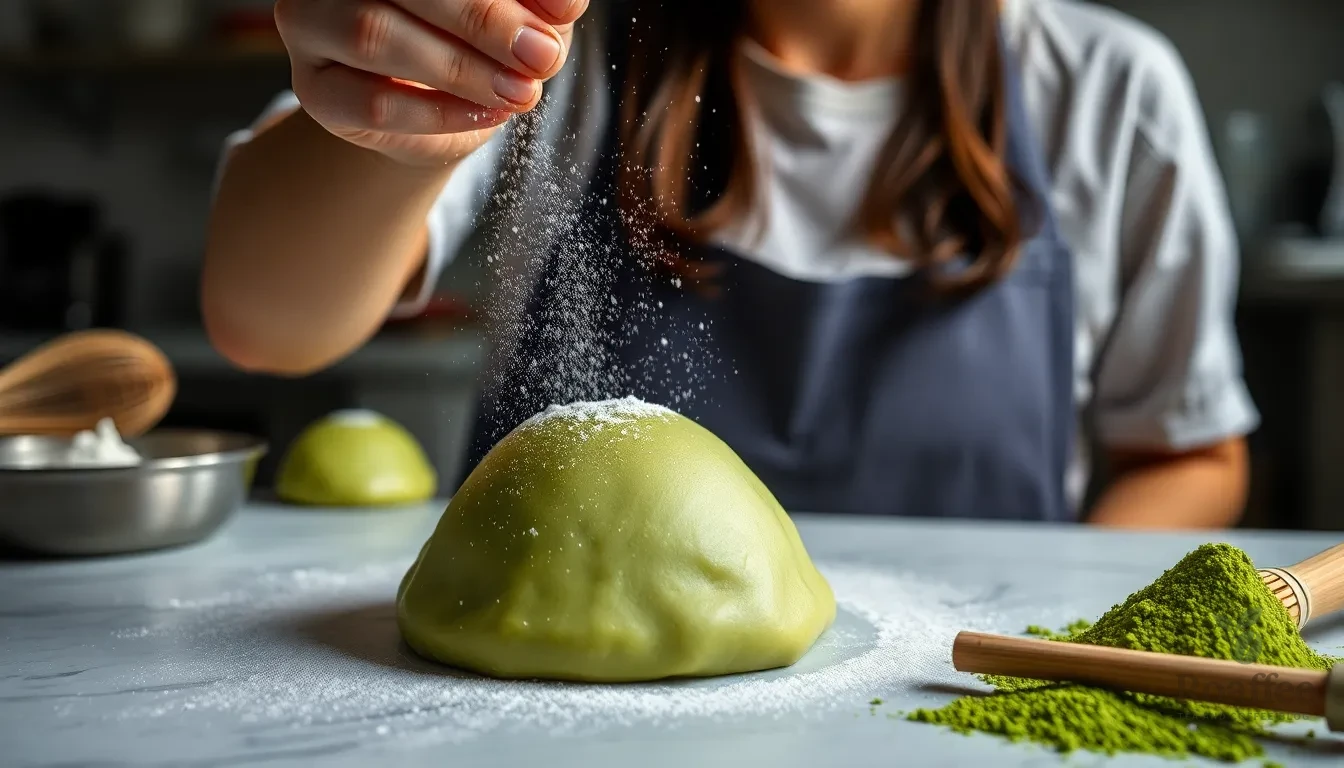
Mastering green tea mochi requires attention to exact techniques that ensure the perfect balance of texture, flavor, and appearance. These professional tips will help you create restaurant-quality mochi with consistent results every time.
Achieving the Right Texture
The microwave method delivers superior results when executed properly. We whisk the shiratamako and water thoroughly until completely homogeneous to prevent lumps from forming. Cover the mixture with a paper towel instead of plastic wrap to avoid dangerous steam burns during heating.
Microwave the dough in short 30-second intervals while stirring between each session. This gradual cooking process ensures the dough becomes opaque and fully cooked without developing tough spots. The steaming method also produces excellent results when combined with proper resting time.
Allow the dough to rest after cooking as this step significantly improves both chewiness and softness. Avoid overcooking the mochi as excessive heat makes the final product tough and difficult to chew.
Working with Sticky Dough
Generous amounts of starch create your best defense against sticky dough disasters. We dust our working surface heavily with potato starch or cornstarch before handling the cooked mochi. Your hands should also receive a thorough dusting with starch to prevent the dough from adhering to your skin.
Handle the dough with gentle movements rather than aggressive kneading or pressing. Cool the dough slightly after cooking to reduce its stickiness and make shaping much easier. The dough becomes more manageable as it reaches a comfortable handling temperature.
Keep additional starch nearby throughout the shaping process. Reapply starch to your hands and work surface as needed to maintain smooth handling conditions.
Color and Flavor Balance
Matcha powder quantity directly controls both flavor intensity and visual appeal. One teaspoon of matcha provides mild green tea notes perfect for beginners. Two teaspoons or more create stronger matcha flavors that appeal to green tea enthusiasts.
| Matcha Amount | Flavor Profile | Color Intensity |
|---|---|---|
| 1 teaspoon | Mild green tea | Light green |
| 2 teaspoons | Moderate matcha | Medium green |
| 3+ teaspoons | Strong matcha | Deep green |
High-quality ceremonial grade matcha powder produces the most vibrant green color and cleanest flavor. Balance the sugar content carefully to complement matcha’s natural slight bitterness without overwhelming the delicate green tea taste.
Consider incorporating matcha into both the filling and the dough for layered flavor complexity. This dual approach creates beautiful color contrast while intensifying the overall green tea experience throughout each bite.
Variations and Substitutions
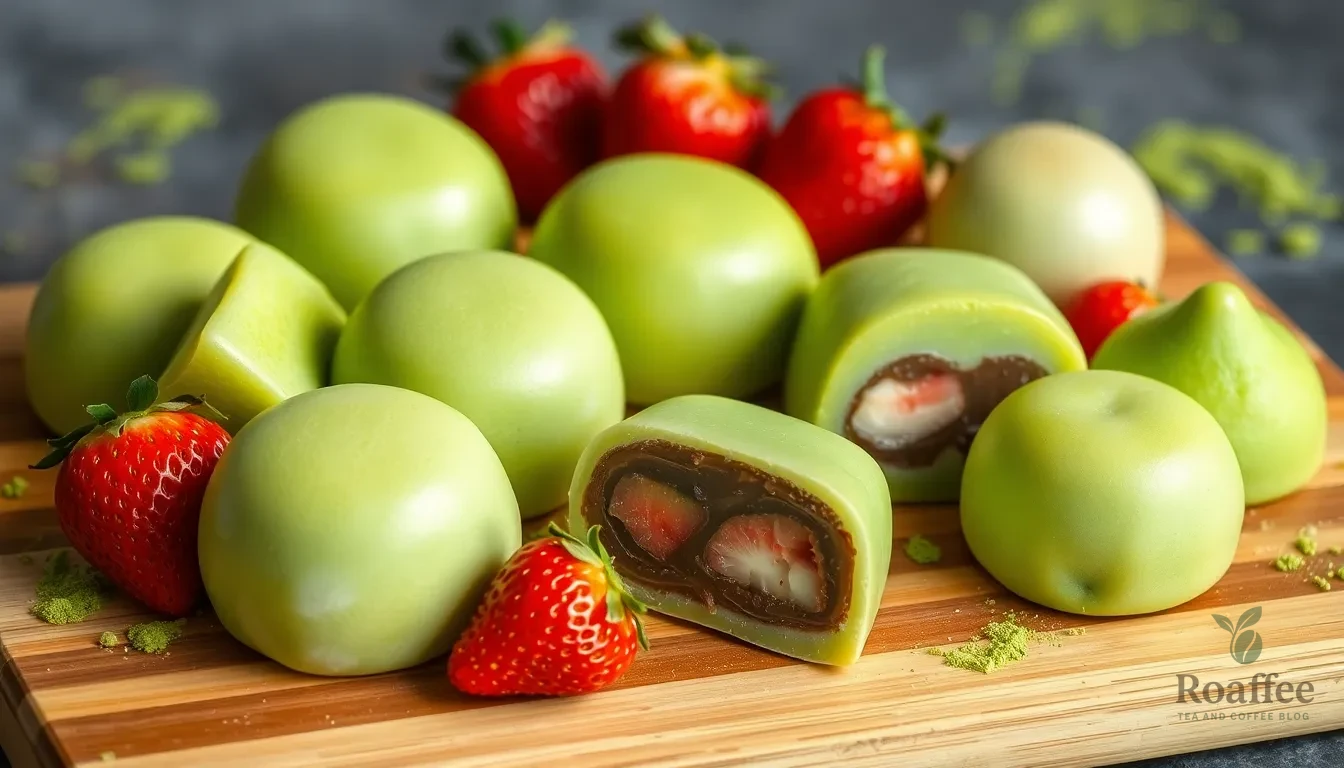
We understand that every home baker has different preferences and dietary needs, which is why green tea mochi offers incredible flexibility for customization. The beauty of this recipe lies in its adaptability, allowing you to create unique versions that suit your taste and requirements.
Filling Variations
Our green tea filling provides an excellent base, but you can explore many delicious alternatives. Traditional red bean paste (anko) offers authentic Japanese flavor and pairs beautifully with the matcha-infused mochi exterior. White bean paste (shiroan) creates a milder, more subtle sweetness that lets the mochi’s texture shine. For chocolate lovers, we recommend matcha chocolate ganache made with white chocolate, butter, cream, and additional matcha powder for an indulgent, rich filling that melts in your mouth.
Fresh fruit fillings bring lightness and natural sweetness to the dessert. Strawberry pieces wrapped in cream create a delightful contrast of textures and flavors. We’ve found that small pieces of Japanese pears or even mango work exceptionally well for tropical variations.
Mochi Dough Adaptations
The traditional mochi dough can be modified to create striking visual and flavor combinations. We often prepare half the dough plain and half with matcha powder, creating beautiful two-toned mochi that showcases both colors. This technique requires dividing your dough mixture before adding the matcha to one portion.
For those seeking a cake-like texture, butter mochi versions incorporate eggs, butter, milk, and baking powder alongside the matcha. This creates a completely different dessert experience while maintaining the beloved green tea flavor profile.
Dairy Substitutions
Plant-based alternatives work seamlessly in this recipe without compromising flavor or texture. Coconut milk substitutes perfectly for heavy cream in the filling, adding natural sweetness and tropical notes that complement the matcha beautifully. We’ve tested almond milk, oat milk, and soy milk as dairy replacements, with coconut cream being our top choice for replacing heavy cream due to its rich consistency.
These substitutions maintain the creamy texture essential for proper mochi assembly while accommodating various dietary restrictions.
Flavor Enhancements
Sugar quantities can be adjusted according to your sweetness preference without affecting the mochi’s structural integrity. We recommend starting with the base recipe and adjusting future batches to taste. Vanilla extract or vanilla bean paste enhances the filling’s aroma and adds depth to the matcha flavor profile.
For additional texture and visual appeal, consider incorporating toppings like toasted sesame seeds, desiccated coconut, or mini chocolate chips into your filling mixture. These additions create delightful surprises in every bite while maintaining the mochi’s traditional appeal.
Make-Ahead Instructions
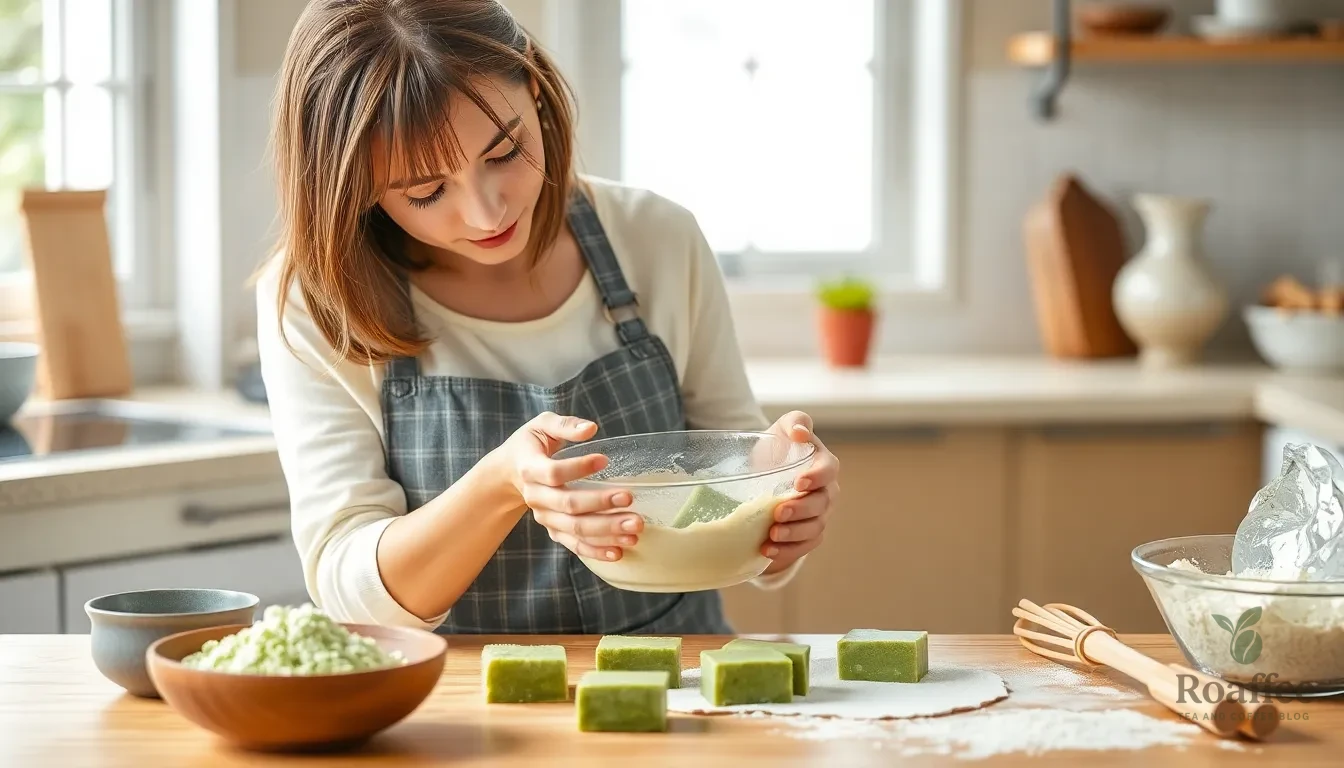
Planning your green tea mochi preparation ahead of time transforms this delicate Japanese dessert into a stress-free entertaining option. We recommend preparing different components at various stages to maximize freshness while accommodating your schedule.
Preparing the Green Tea Filling
The matcha filling benefits from advance preparation and actually improves in flavor when made ahead. We suggest mixing the heavy cream, powdered sugar, matcha powder, honey, vanilla extract, and salt up to 2 days before assembling your mochi. Store this mixture in the refrigerator in an airtight container, allowing the matcha flavors to develop and intensify.
Before using the chilled filling, let it sit at room temperature for 10-15 minutes to soften slightly for easier handling. This timing ensures the filling maintains its shape during assembly while remaining pliable enough to work with effectively.
Making Mochi Dough Components
Glutinous rice flour mixtures can be prepared and stored separately from liquid ingredients. We recommend combining the dry ingredients (glutinous rice flour, sugar, and salt) in an airtight container up to 1 week before use. This preparation method saves time on the day of cooking and ensures consistent measurements.
Keep the measured water and vegetable oil ready in the refrigerator up to 24 hours before cooking. Room temperature liquids integrate more smoothly with the flour mixture, so remove them from refrigeration 30 minutes before beginning the cooking process.
Assembly Timeline Strategy
We find that preparing mochi dough and filling components requires approximately 30 minutes of active chilling time for optimal results. Plan your assembly session when you have 45 minutes of uninterrupted time, as the sticky dough requires immediate attention once cooked.
Complete assembly works best when both components are at their ideal temperatures. The filling should be firm but not rock-hard, while the cooked mochi dough needs to be warm and pliable for easy shaping.
Storage Timeline Reference
| Preparation Stage | Refrigerator Storage | Room Temperature | Freezer Storage |
|---|---|---|---|
| Green tea filling | 2 days | 4 hours | 1 month |
| Dry ingredients | N/A | 1 week | 6 months |
| Assembled mochi | 1 week | 24 hours | 3 months |
| Cooked dough only | 3 days | 6 hours | 2 months |
Final Assembly Considerations
We suggest completing the final assembly no more than 24 hours before serving for optimal texture and flavor. Mochi dough maintains its signature chewiness best when consumed within this timeframe, though properly stored mochi remains safe to eat for longer periods.
Dust your finished mochi with the powdered sugar and matcha mixture just before serving rather than during storage. This approach prevents the dusting from absorbing moisture and maintains the vibrant green color that makes green tea mochi so visually appealing.
Conclusion
We’ve shared everything you need to create delicious green tea mochi that rivals your favorite Japanese confectionery. With our detailed instructions and professional tips you’ll master this elegant dessert’s perfect balance of chewy texture and vibrant matcha flavor.
The beauty of homemade green tea mochi lies in its versatility and the satisfaction of crafting something truly special. Whether you’re preparing for a dinner party or treating yourself to an authentic Japanese experience our recipe ensures consistent results every time.
Remember that practice makes perfect with mochi-making. Don’t be discouraged if your first batch isn’t flawless – each attempt brings you closer to achieving that coveted soft stretchy texture. Store your creations properly and enjoy them at their peak for the ultimate green tea mochi experience.
Frequently Asked Questions
What is green tea mochi?
Green tea mochi is a traditional Japanese dessert combining chewy mochi (rice cake) made from glutinous rice flour with a creamy matcha-flavored filling. The mochi wrapper has a soft, stretchy texture, while the filling provides earthy, slightly sweet green tea flavor. It’s an elegant treat that balances the richness of matcha with the satisfying chewiness of mochi.
How long does homemade green tea mochi last?
Homemade green tea mochi stays fresh at room temperature for 1-2 days when stored in an airtight container. For longer storage, refrigerate for up to one week, though the texture may become firmer. You can also freeze individually wrapped pieces for up to one month. Always allow chilled mochi to return to room temperature before serving.
Can I make green tea mochi without a steamer?
Yes, you can easily make green tea mochi without a steamer using the microwave method. Simply combine the glutinous rice flour mixture in a microwave-safe bowl and cook in short intervals, stirring between each session until the dough becomes translucent. This method is actually more convenient and produces excellent results for home cooks.
What type of matcha powder should I use?
Use high-quality culinary-grade matcha powder for the best flavor and vibrant green color. Avoid ceremonial-grade matcha as it’s more expensive and designed for tea ceremonies. Look for matcha that’s bright green rather than yellowish-brown, which indicates freshness. The quality of matcha significantly impacts both taste and visual appeal of your mochi.
How do I prevent the mochi dough from sticking?
Generously dust your work surface, hands, and tools with potato starch or cornstarch before handling the mochi dough. Work quickly while the dough is still warm and pliable, and avoid over-kneading. Keep extra starch nearby for dusting as needed. If the dough becomes too sticky, add more starch gradually until manageable.
Can I make green tea mochi dairy-free?
Yes, you can substitute the heavy cream with coconut milk or other plant-based alternatives to make dairy-free green tea mochi. The coconut milk will add a subtle tropical flavor that complements the matcha. Other options include cashew cream or silken tofu blended with a little plant milk for a creamy consistency.
What’s the best way to serve green tea mochi?
Serve green tea mochi at room temperature after letting it rest for 15-20 minutes. Dust with a mixture of powdered sugar and matcha powder just before serving. Arrange on a clean plate or use paper cupcake liners for special occasions. Pair with jasmine tea or light oolong tea for an authentic experience.
How far in advance can I prepare green tea mochi?
You can prepare the green tea filling up to 2 days in advance and store it refrigerated. The dry ingredients can be combined up to a week ahead. However, assemble the final mochi no more than 24 hours before serving to maintain optimal texture. Dust with powdered sugar and matcha just before serving for best appearance.













